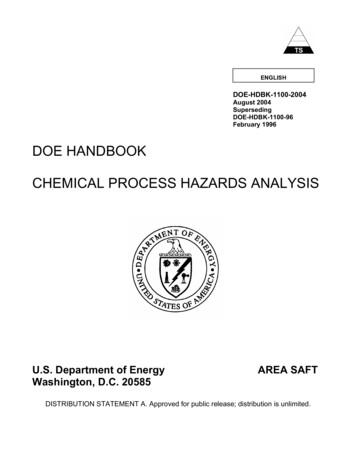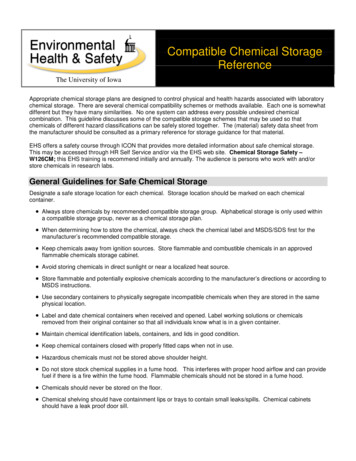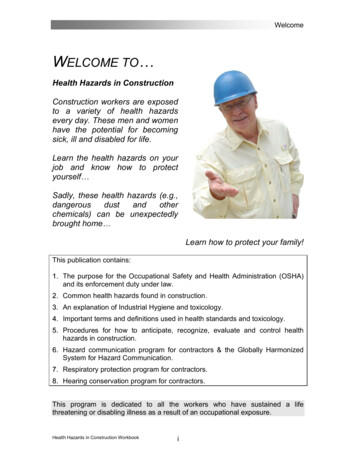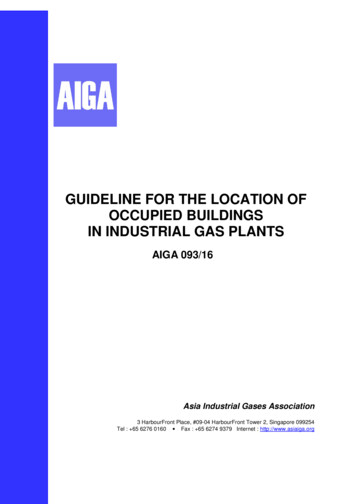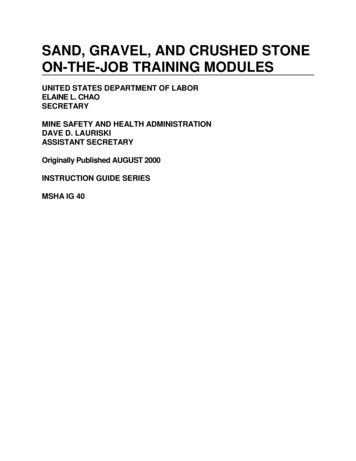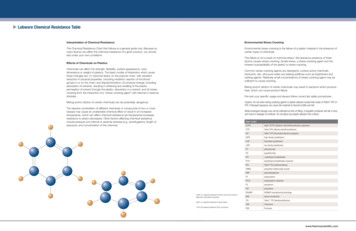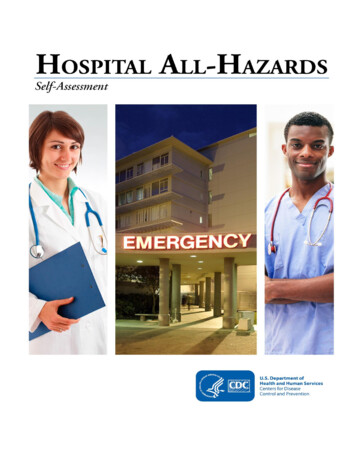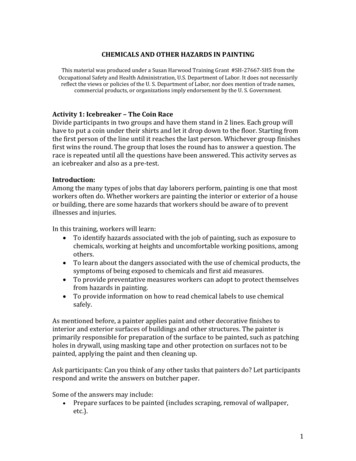
Transcription
CHEMICALS AND OTHER HAZARDS IN PAINTINGThis material was produced under a Susan Harwood Training Grant #SH-27667-SH5 from theOccupational Safety and Health Administration, U.S. Department of Labor. It does not necessarilyreflect the views or policies of the U. S. Department of Labor, nor does mention of trade names,commercial products, or organizations imply endorsement by the U. S. Government.Activity 1: Icebreaker – The Coin RaceDivide participants in two groups and have them stand in 2 lines. Each group willhave to put a coin under their shirts and let it drop down to the floor. Starting fromthe first person of the line until it reaches the last person. Whichever group finishesfirst wins the round. The group that loses the round has to answer a question. Therace is repeated until all the questions have been answered. This activity serves asan icebreaker and also as a pre-test.Introduction:Among the many types of jobs that day laborers perform, painting is one that mostworkers often do. Whether workers are painting the interior or exterior of a houseor building, there are some hazards that workers should be aware of to preventillnesses and injuries.In this training, workers will learn: To identify hazards associated with the job of painting, such as exposure tochemicals, working at heights and uncomfortable working positions, amongothers. To learn about the dangers associated with the use of chemical products, thesymptoms of being exposed to chemicals and first aid measures. To provide preventative measures workers can adopt to protect themselvesfrom hazards in painting. To provide information on how to read chemical labels to use chemicalsafely.As mentioned before, a painter applies paint and other decorative finishes tointerior and exterior surfaces of buildings and other structures. The painter isprimarily responsible for preparation of the surface to be painted, such as patchingholes in drywall, using masking tape and other protection on surfaces not to bepainted, applying the paint and then cleaning up.Ask participants: Can you think of any other tasks that painters do? Let participantsrespond and write the answers on butcher paper.Some of the answers may include: Prepare surfaces to be painted (includes scraping, removal of wallpaper,etc.).1
Determine what materials will be needed.Use, clean and maintain various equipment.Mix paintings.Supervise apprentices or other workers.Ask participants to share if they have had any incidents when working with paint.Allow time to hear their stories and keep a note of the incidents, as those stories willbe used to illustrate the hazards that workers are exposed to in the industry ofpainting.Activity 2: Learning the HazardsExplain to participants: Painters can work at a variety of workplaces, constructionsites, homes, renovation, etc. and constantly face different hazards. There are manywork place issues that can affect potential exposure to hazardous materials used bypainters. By considering the main issues and taking some action, employers andworkers can more effectively reduce workers’ exposure to the hazardous products.A hazard is the potential for harm (physical or mental) to the health and safety ofpeople.Work hazards can be divided in the following categories. (For each category, askparticipants to give you examples). Participants will be able to look at images thatrepresent each hazard. Safety hazards can cause immediate accidents and injuries. Examplesare hot surfaces, broken ladders, and slippery floors. Safety hazards canresult in burns, cuts, broken bones, electric shock, or death. Physical hazards are factors within the environment that can harm thebody without necessarily touching it. Physical Hazards include: radiation,high exposure to sunlight/ultraviolet rays, extreme temperatures andconstant loud noise. Chemical hazards are present when a worker is exposed to any chemicalpreparation in the workplace in any form (solid, liquid or gas). Some aresafer than others, but to some workers who are more sensitive tochemicals, even common solutions can cause illness, skin irritation, orbreathing problems. Examples include cleaning products, asbestos, andpesticides. Biological hazards are associated with working with animals, people, orinfectious plant materials. Work in schools, day care facilities, collegesand universities, hospitals, laboratories, emergency response, nursinghomes, outdoor occupations, etc. may expose you to biological hazards.They include viruses, bacteria, mold, body fluids, animal droppings,plants, etc. Ergonomic hazards occur when the type of work, body positions andworking conditions put strain on your body. They are the hardest to spotsince you don’t always immediately notice the strain on your body or the2
harm that these hazards pose. Short-term exposure may result in “soremuscles” the next day or in the days following exposure, but long-termexposure can result in serious long-term illnesses. Some of the hazardsinclude frequent lifting, poor posture, awkward movements, repeatingthe same movements over and over, having to use too much force, etc.Work organization hazards are hazards or stressors that cause stress(short-term effects) and strain (long-term effects). These are the hazardsassociated with workplace issues such as workload, lack of controland/or respect, etc. Examples of work organization hazards includeworkload demands, intensity and/or fast pace, respect (or lack of), sexualharassment, etc.BEWARE: some hazards can cause immediate damage, such as the safety hazards orchemicals that can cause skin eruptions, but sometimes the symptoms of an illnesscan appear months or years after.Using the color category table provided, and color dot stickers, ask participants tostick color dots that correspond to the type of hazard that each represent. And askthem to explain why they chose the categories of hazards they did.Type of HazardColorSafety HazardsPhysical HazardsChemical HazardsBiological HazardsErgonomic HazardsWork OrganizationHazards3
Here are the hazards to be categorized: Working at heights. Using ladders, platforms and scaffolds. Working in confined spaces. Risk of eye injury. Slips, trips and falls. Risk of injury from falling objects. Exposure to mold, fungi and bacteria. Exposure to bird and rodent droppings. Exposure to paint products, solvents, lead and other toxic substances. Proximity to flammable or combustible materials. Working in awkward positions, or performing repetitive physical tasks. Standing for long periods of time. Lifting heavy or awkward objects. Exposure to heat and ultraviolet radiation. Noise. Stress. Breathing toxic materials. Electrical hazards from working close to live electrical power lines orequipment. Shift work or extended work days. Working at a fast pace.Note: Have the hazards written on butcher paper prior to the training so that you donot have to write them on the spot. More hazards can be added.Activity 3: Let’s Understand ChemicalsExplain to the participants: Nowadays, the use of chemicals has spread to almost allbranches of work activities; therefore, there are risks in many work places and inparticular in the trade of painting. There are thousands of chemical substances thatare used in large and small quantities, and there are many new ones introducedeach year. Unfortunately, most people do not know how to read labels on chemicalproducts or handle them with the necessary precautions. However, it is your right toknow and it is important to be well informed of the correct and safe use of chemicalsat the workplace.The first and most essential step leading to the safe use of chemicals is to know whatthey are used for and to understand the hazards they pose to your health and theenvironment, in order to be able to control them. Workers must have theinformation of the chemicals they are going to use, as well as the hazards they poseand safety measures.Does anyone know what chemicals are used in paint and what are they usedfor? Paint contains several kinds of material: pigments, binders, extenders, solventsand additives. The additives themselves can include a vast array of materials, such4
as dispersants, silicones, thixotropic agents, driers, anti-setting agents, bactericides,and fungicides and algaecides.All the pigments in paint are used to set the color and opacity. The binder, or resin,holds the pigment in place. With the extender, large pigment particles are added toimprove adhesion, strengthen the film and save on binder. There is also the solventor thinner, which can either be organic or water, that is used to reduce the thicknessof the paint to make its application better and easier. Along with those baseingredients, the additives within paint consists of several substances. For example,there are also silicones, which are used to improve the paint's weather resistanceand driers are placed in paint to accelerate the drying time. Anti-settling agents areused in paint to prevent pigment settling. The final additives in paint are thefungicides and algaecides, which are used to protect exterior paint from molds,algae and lichen.After reviewing the materials in paint, explain to participants that:Chemicals are organic and inorganic substances, they may be natural or synthetic,toxic or not and they can harm people or the environment.Hazardous chemical products are those that can harm people or the environment.Every day we are exposed to countless chemical products that have becomeessential in our life but unfortunately we are not informed about their effects andconsequences. Even nowadays, the possible effect that many products can produceon people’s health and on the environment is not exactly known.Physical Form of Chemicals: The physical form of a chemical can influence the wayin which it enters the organism, and to some extent, the harm it causes. The mainphysical forms of chemicals are solids, dusts, liquids, vapors and gases.Solids Solids are the least likely of the chemical forms to cause chemical poisoning.However, certain chemical solids can cause poisoning if they get onto yourskin or food and you then ingest them. Personal hygiene is important to prevent the ingestion of chemical solids. The greatest danger with solids is that some work processes can changethem into a more dangerous form.Liquids Many hazardous substances, for example acids and solvents are liquid inroom temperature. Many liquid chemicals detach vapors that can be inhaled.5
The skin can absorb liquid chemicals. Some liquid chemicals can damage theskin immediately. Other liquids go on directly through the skin to thebloodstream, from which they can transfer to different parts of the organismand have harmful effects. It is necessary to apply control measures for liquid chemicals to eliminate orto diminish the possibility of inhalation, exposure to the skin and damage tothe eyes.Vapors The steams are droplets of liquid suspended in the air. A lot of chemical liquid substances evaporate at room temperature, whichmeans that they form a vapor and remain in the air. Vapors from some chemicals can irritate the eyes and the skin. The inhalation of certain chemical toxic vapors can have different serioushealth consequences. Vapors can be flammable or explosive. To avoid fires or explosions, it isimportant to keep the chemical substances that evaporate far from heatsources. There should be control measures to avoid exposure of workers to thevapors that emit from liquids, solids or any other state of chemicals.Gases Some chemicals are in the form of gas at room temperature. Other chemicals,in liquid or solid form, turn into gases when they warm up. It is easy to detect some gases for based on their color or smell, but there areother gases that cannot be seen nor smelled, and they can only be detectedthrough the use of special equipment. Gases can be inhaled. Some gases produce irritating effects immediately. The effects that othergases have in the health of people can only be identified once the health ofthe individual has been seriously compromised. Gases can be flammable or explosive. It is necessary to be cautious whenworking in a place where there are explosive and flammable gases. Forexample, when working with a gas paint spray gun, it is important to keepany ignitions sources away from your work area. Or when welding, it isimportant to not work near the welding cylinder storage. Workers should be protected at the workplace from the possible hazardouseffects of chemical gases through efficient control measures.6
Note: Working in confined spaces like boilers and tanks is especially dangerousbecause they have low oxygen and/or high amounts of toxic chemicals.Routes of entry to the organism of chemical pollutantsRESPIRATORY ROUTEthrough the nose andthe mouth, the lungs,etc.This is one of the mostimportant routes ofentry or penetrationbecause it is through theair that many toxicsubstances such as dust,smokes, aerosols andgases can enter ourbodies.DIGESTIVE ROUTEthrough the mouth,stomach, intestines, etc.Route of entry throughthe mouth, theesophagus, the stomachand the intestines.Pollutant ingestionsdissolved in mucus in therespiratory systemshould also beconsidered.PARENTERAL ROUTEthrough open wounds,sores, etc.Route of entry of thepollutant to the bodythrough open wounds,sores, etc.7
DERMAL ROUTEthrough the skinRoute of entry of manysubstances that are ableto go through the skinwithout causing erosionor noticeable alterationsand that can enter theblood to later be spreadto the whole body.Activity 4: Controlling Chemical HazardsChemical Labeling – How to read them!Tell participants: Health and safety information on chemical substances is public, soyou have the right to ask for the facts!OSHA’s Hazard Communication standard requires chemical manufacturers orimporters to classify the hazards of chemicals, which they produce or import. Also, itrequires all employers to provide information to their employees about thehazardous chemicals to which they are exposed, by means of a hazardcommunication program, labels and other forms of warning, safety data sheets, andinformation and training.Explain to the participants that OSHA defines a hazardous chemical as anything thatis a physical or health hazard.Physical hazards are pretty straightforward. They include flammable andcombustible liquids, compressed gasses, explosives, etc.Health hazards are a little harder to determine, however OSHA indicates theyinclude pollutants that can cause the following: cancer; birth defects, sensitivity,irritation, damage to the nervous system, damage to different organs (such as theliver, kidneys, lungs, skin), damage to the eyes and mucus membrane, agents of thesystem that produce blood in our bodies.We have stated before that most of us are exposed to chemicals in one way oranother, but how many of us can read a label and understand it? Have any of youread the labels of the chemicals we use?Using labels from different chemical products, ask participants to name theinformation they notice. Write them on a sheet of butcher paper.8
After, go over the different elements of information that a label on a hazardouschemical should have according to OSHA’s Hazard Communication Standard (HCS):1. The Name, Address and Telephone Number of the chemical manufacturer,importer or other responsible party.2. The Product Identifier is how the hazardous chemical is identified. This canbe (but is not limited to) the chemical name, code number or batch number.The manufacturer, importer or distributor can decide the appropriateproduct identifier. The same product identifier must be both on the label andin section 1 of the SDS.3. Signal Words are used to indicate the relative level of severity of the hazardand alert the reader to a potential hazard on the label. There are only twowords used as signal words, “Danger” and “Warning.” Within a specifichazard class, “Danger” is used for the more severe hazards and “Warning” isused for the less severe hazards. There will only be one signal word on thelabel no matter how many hazards a chemical may have. If one of the hazardswarrants a “Danger” signal word and another warrants the signal word“Warning,” then only “Danger” should appear on the label.4. Hazard Statements describe the nature of the hazard(s) of a chemical,including, where appropriate, the degree of hazard. For example: “Causesdamage to kidneys through prolonged or repeated exposure when absorbedthrough the skin.” All of the applicable hazard statements must appear on thelabel. Hazard statements may be combined where appropriate to reduceredundancies and improve readability. The hazard statements are specific tothe hazard classification categories, and chemical users should always seethe same statement for the same hazards no matter what the chemical is orwho produces it.5. Precautionary Statements describe recommended measures that should betaken to minimize or prevent adverse effects resulting from exposure to thehazardous chemical or improper storage or handling. There are four types ofprecautionary statements: prevention (to minimize exposure); response (incase of accidental spillage or exposure emergency response, and first-aid);storage; and disposal. For example, a chemical presenting a specific targetorgan toxicity (repeated exposure) hazard would include the following onthe label: “Do not breathe dust/fume/gas/mist/vapors/spray. Get medicaladvice/attention if you feel unwell. Dispose of contents/container inaccordance with local/regional/national and international regulations.”6. Pictograms are graphic symbols used to communicate specific informationabout the hazards of a chemical. On hazardous chemicals being shipped ortransported from a manufacturer, importer or distributor, the requiredpictograms consist of a red square frame set at a point with a black hazardsymbol on a white background, sufficiently wide to be clearly visible. Asquare red frame set at a point without a hazard symbol is not a pictogramand is not permitted on the label.Note: It is important to read the label each time you use a newly purchasedchemical. It is possible the manufacturer may have added new hazard information9
or reformulated the product since your last purchase, and thus altered the potentialhazards you face while working with the product.SAMPLES OF LABELSCORRECTINCORRECTActivity 5: Recognizing the PictogramsIn this activity, participants will watch a video depicting a cartoon character ‘Napo”involved in some work activities that put him in danger when using chemicals. Thevideo can be found at filmid napo-012-danger-chemicals.After watching the video, participants will be asked to pick one card from a pile.Each card corresponds to a pictogram, the name of the pictogram and the hazards.They will then have to look for the other participants that have the components thatcorrespond to each other. For example the person with the card that says “healthhazard” will have to look for the person that has the pictogram of the health hazardand also for the person that has the actual hazards. Once the participants with thematching cards have found each other, they will have to talk to each other about thesymbol they have and what is its potential for danger. They will have to come upwith an example of a chemical product they have seen this symbol on or if they haveexperienced an accident produced by that particular hazard. This activity will helpreview what they saw on the video, as well as a discussion.Health Hazard CarcinogenMutagenicityReproductive toxicityRespiratory sensitizerTarget organ toxicityAspiration toxicity10
Flame FlammablesPyrophoricsSelf-HeatingEmits Flammable GasSelf-ReactivesOrganic PeroxidesExclamation Mark Irritant (skin and eye)Skin SensitizerAcute Toxicity (harmful)Narcotic EffectsRespiratory Tract IrritantHazardous to Ozone Layer(Non-Mandatory)Gas Cylinder Gases Under PressureCorrosion Skin Corrosion/ BurnsEye DamageCorrosive to MetalsExploding Bomb ExplosivesSelf-ReactivesOrganic PeroxidesFlame Over Circle Oxidizers11
Environment (NonMandatory) Aquatic ToxicitySkull andCrossbones Acute Toxicity (fatal or toxic)Activity 6: Understanding Safety When handling Chemicals (2 hours)In this activity we will teach participants how to read the NFPA Chemical HazardLabel. We will go over what each color and symbol represents. We will follow bygiving them samples of labels found in products that are commonly used in differentjobs day laborers perform; for example glass cleaner, thinner, crack sealant, paint,wood stain, etc. Participants will have to fill out a blank NFPA Chemical Hazard labelwith information about a chemical we will provide.You may have noticed a diamond shaped label with 4 different colors and numbersin some chemical products. The label may look simple, but it actually carries a lot ofinformation and it may help you identify the hazards associated with that product.This label is color-coded and each color represents a different type of hazard. Also,as mentioned before, it also uses a number system and each number represents thedegree of a particular hazard.12
Special Notice Key (White)- This table contains special indications for someproducts. For example, if it is an oxidizing product, corrosive, water reactive orradioactive.Example:Note: Regardless of the numbers on the label - even if they carry ones or zeros - becautious. All chemicals should be treated with the utmost of care.Safety Data Sheets – SDSThe Hazard Communication Standard (HCS) requires chemical manufacturers,distributors, or importers to provide Safety Data Sheets (SDSs) to communicate thehazards of hazardous chemical products. SDSs must be in a uniform format, andinclude the properties of each chemical; the physical, health, and environmentalhealth hazards; protective measures; PPE; stability and reactivity; and safetyprecautions for handling, storing, and transporting the chemical.Activity 7: Types of Paint and Chemicals Used in PaintingLet’s explore the basic types of paint and chemical products used in painting and thedangers they pose:Water Based Paint: Health risks are low, but could affect people who are verysensitive to smells or people allergic to vapors from paint. These products do notpose immediate fire risk. If you get paint on you, wash your hands and any part ofyour body exposed to the paint with water and soap (do not use detergent).Oil Based Paint: Oil paint is a type of slow-drying paint that consists of particles ofpigment suspended in a drying oil, commonly linseed oil. Oil-based paint containspotentially poisonous hydrocarbons, and high levels of volatile organic compounds,13
or VOCs, which perform numerous functions in paint and evaporate as the paintdries. The most significant health effects of oil-based paint are due to polluted airfrom VOCs, inhalation and poisoning. These products can catch fire if they areexposed to excessive temperatures or high temperatures for a long time.Paint Remover: is a product designed to remove paint and other finishes and alsoto clean the underlying surface. Two basic categories of chemical paint removers arecaustic and solvent. The active ingredients inmost common paint removers areorganic solvents, which may damage the skin, eyes, respiratory tract, nervoussystem, and internal organs. Special precautions must be taken in their use. The firecausing potential of solvents can be classified as "extremely flammable,""flammable," combustible," or "non-flammable."Paint Thinner: paint thinner is a solvent used to thin oil-based paints or clean upafter their use. It contains chemicals that are hazardous to human health. They cancause headaches, nausea, depression if inhaled, confusion, and respiratory distress.It can irritate the skin, eyes, nose and throat when inhaled and also has anestheticqualities. Many of these elements are also highly flammable.Activity 8: Other Hazards to Look Out for when PaintingMaking reference to the answers participants gave during activity 2, review thefollowing hazards with participants. After, divide participants in 5 groups and assignone hazard to each group. Participants have to come up with a basic preventativeplan so that workers are not exposed to the particular hazard they were assigned intheir group. Presentations will follow.Exposure to silica: Silica is widely used in concrete and masonry products, such asthe fillers and stuccos. When the product is sanded, grinded, or mixed, the dustcontaining silica may become airborne. When silica particles are inhaled, especiallythe crystalline silica, it can become trapped in the lung tissue. The lung tissue thenreacts by developing fibrous tissue around the trapped silica particles. Thiscondition, which is known as silicosis, is a chronic condition that takes many yearsto develop.Prevention:Exposure to lead: Lead exposure occurs when lead laden dust and fumes areinhaled while painting with lead-based paint, grinding/sanding old lead-based paint,or hot work on metals containing lead. Lead can also enter the body when it isaccidentally ingested from contaminated hands, food, water, cigarettes and clothing.Lead is released into the blood and distributed throughout the body. Most of itaccumulates in the bones where it can be stored and then released into the blooddecades later, causing exposure to organs.Falls: Falling from high places, such as ladders, scaffolds, elevated platforms arecommon accidents when painting. The causes for falls can be several, but among the14
most common are slips, trips, cluttered working spaces and using unstable laddersand scaffolds.Electrical Hazards: Electric shocks, depending on certain conditions, can be fatal,even at relatively low voltages. The amount of time that an electrical current lastshas a great influence in the severity of the injuries. If the electric current has a shortduration, then it may just cause pain. If the electric shock is longer, then it can befatal, even if the voltage is not very high. It is important to note that workers and alltools need to be at least 10 feet away from energized power lines.Musculoskeletal Disorders: When we load, lift, push, drag, or hold something weare using too much strength and therefore putting a lot of strain on our muscletissues and ligaments. Another common injury for painters is caused by the frequentand repeated manipulation of their tools (brushes, rollers, sprayers, etc.), even ifyou don't need to use much strength. The damage is caused by the excessive effortto which the parts and fibers of the muscle undergo during long periods of time.After reviewing each of the hazards, have an open discussion with participantsabout how to avoid the dangers posed by the hazards and what would be some waysof accident and illness prevention.Activity 9: How can I protect myself from hazardous chemicals?Let participants know that it is very important for them to be well informed of thechemical products they have to use when working as painters and to know what todo in case they are overexposed to chemical hazards. Since day laborers often do nothave the proper training, it is important for them to be aware of a few things theycan do that can potentially protect them and their co-workers:The Right to Know- everyone who works with toxic substances should know thenames, toxicity, and other hazards of the substances they use. Employers arerequired by law to provide this information, along with training in how to use toxicsubstances safely.Permissible Exposure Limits (PELs)- It is important to understand how long wecan be exposed to a chemical. Health and safety authorities establish the exposurelimits of hazardous substances. OSHA PELs are based on an 8-hour time weightedaverage (TWA) exposure. An employer can be cited and fined if employees areexposed over the PEL.Exposure limits usually represent the maximum amount (concentration) of achemical, which can be present in the air without presenting a health hazard.However, exposure limits may not always be completely protective, for thefollowing reasons:15
Information for chronic health effects is not complete because it may takemany years for an illness to appear.Workers can be affected by chemical exposure at different levels dependingon their own physical state and how much strength is needed to performtheir job.Chemical interactions are not taken into account. How many differentchemical products are being used?Limiting the chemical concentration in air may not prevent excessiveexposure through skin contact or ingestion.Ventilation- Ventilation is one of the most effective methods for controlling solventvapors and dusts generated by paint activities by either supplying or exhausting air.Always make sure there is circulation of fresh air sufficient to keep concentrationsof toxic substances diluted below hazardous levels. There are two main types ofventilation methods: general ventilation (or dilution ventilation) and local exhaustventilation.General ventilation is used to describe a ventilation system that supplies andexhausts large volumes of air from work areas. This method is effective when youwant to dilute low concentrations of vapor or dust from painting activities toacceptable levels. Examples of general ventilation systems are the use of naturaldrafts through open windows and doors, roof ventilators, or mechanical fans orblowers mounted in roofs, walls or windows.Local exhaust ventilation refers to a ventilation method that contains or “captures”contaminants at their source of generation before they escape into the workenvironment and to the worker. A typical local exhaust ventilation system consistsof a hood (captures the contaminant), ducts (transports the contaminant away fromthe work area), an air cleaner if required (cleans the contaminants from the air) anda fan
painting. Activity 2: Learning the Hazards . Explain to participants: Painters can work at a variety of workplaces, construction sites, homes, renovation, etc. and constantly face different hazards. There are many work place issues that can affect potential e
